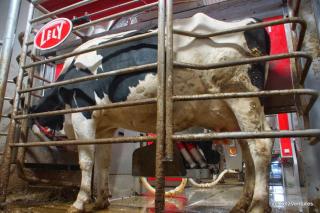Lucas Sjostrom with Dairy Herd Management recently attended the Lely Farm Management Support (FMS) Conference and wrote this article based on an informative session by speaker Gerard Cramer, DVM, DVSc, an associate professor at the University of Minnesota’s School of Veterinary Medicine who specializes in hoof health. Read an excerpt below or the entire article here.
Hoof trimming: Make the most of trimming day
By Lucas Sjostrom, Dairy Herd Management.
- Hoof trimming: An art lacking science?
- Hoof trimming: Make the most of hoof trimming day
- Hoof trimming: Prevent and treat lameness, with a purpose
Hoof trimming as a science has much to learn. But it will take a number of years and a lot of funding before the verdict drops on the best time, way, and frequency to trim for cow hoof health. In the meantime, your hoof trimmer is likely going to keep showing up. Make the most of hoof trimming day by following these tips from Gerard Cramer, DVM, DVSc, an associate professor at the University of Minnesota’s School of Veterinary Medicine specializing in hoof health.
1. Collect hoof trimming data accurately
Most dairy producers and hoof trimmers are collecting some sort of data on hoof trimming day, but make sure it’s accurate. Not everything is an abscess.
“Most trimmers are recording something, but people in the industry aren’t necessarily using the data very effectively,” Cramer explained. “We’re probably making it too complicated. If we record only white line disease, sole ulcers, digital dermatitis, and maybe thin soles, everything else is important to the cow, but they don’t happen often enough to make decisions at the herd level.”
2. Use the data collected effectively
Nearly every hoof trimmer collects some data, transferring it to the dairy farm’s management team in written or electronic form. What happens next is up to you.
Was it a bad month for feet and legs, or is there something you can correct to make the next trim better?
“It needs to be looked at and analyzed in some form, so it can be monitored like we monitor somatic cell count, disease prevalence, or D.A. incidence,” Cramer suggested. “We should be able to say, ‘My incidence of sole ulcers is 3%.’ We also need a goal for it, like most dairies have a realistic goal for somatic cell count. If I ask dairies today what their goal is for lameness, they struggle with it.
“In an ideal world, I want to be able to walk on a dairy and ask, ‘What’s your preg risk goal?’ Okay, ‘What’s your lameness goal?’ and they would quickly turnaround with percentage answers to both questions,” Cramer said. “Lameness is going to happen, but we should be working towards a goal.”
3. Know the causes of the disease affecting your herd
- Sole ulcers. “If I have a herd with a sole ulcer problem, I basically deal with standing time,” Cramer said. “This could include any part of the time budget that includes standing time, focusing on the transition period. It could be heat stress, parlor management, or stall sizing.”
- White line disease.If white line is your top issue, flooring is most likely the problem, Cramer said. Watch for cows slipping or areas of uneven flooring. (See sidebar to learn more.)
- Digital dermatitis.Hygiene and foot bathing are the areas to target.
- Thin soles. Thin soles are caused by over-wearing, either by the grinder or by the floor.
Read the entire article here.

